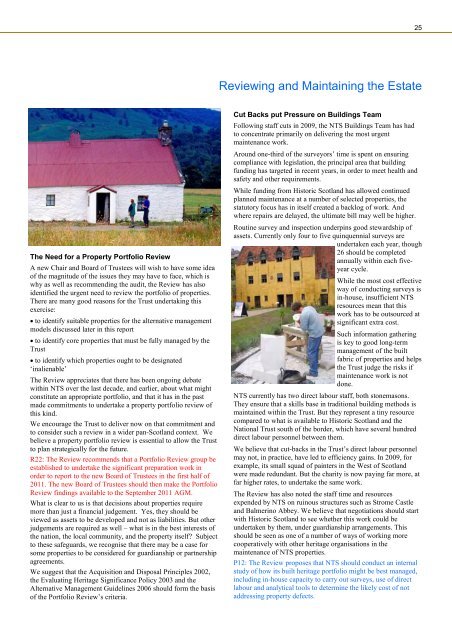NTS Report 4 Aug 2010 - National Trust for Scotland
NTS Report 4 Aug 2010 - National Trust for Scotland
NTS Report 4 Aug 2010 - National Trust for Scotland
You also want an ePaper? Increase the reach of your titles
YUMPU automatically turns print PDFs into web optimized ePapers that Google loves.
25<br />
Reviewing and Maintaining the Estate<br />
The Need <strong>for</strong> a Property Portfolio Review<br />
A new Chair and Board of <strong>Trust</strong>ees will wish to have some idea<br />
of the magnitude of the issues they may have to face, which is<br />
why as well as recommending the audit, the Review has also<br />
identified the urgent need to review the portfolio of properties.<br />
There are many good reasons <strong>for</strong> the <strong>Trust</strong> undertaking this<br />
exercise:<br />
• to identify suitable properties <strong>for</strong> the alternative management<br />
models discussed later in this report<br />
• to identify core properties that must be fully managed by the<br />
<strong>Trust</strong><br />
• to identify which properties ought to be designated<br />
‘inalienable’<br />
The Review appreciates that there has been ongoing debate<br />
within <strong>NTS</strong> over the last decade, and earlier, about what might<br />
constitute an appropriate portfolio, and that it has in the past<br />
made commitments to undertake a property portfolio review of<br />
this kind.<br />
We encourage the <strong>Trust</strong> to deliver now on that commitment and<br />
to consider such a review in a wider pan-<strong>Scotland</strong> context. We<br />
believe a property portfolio review is essential to allow the <strong>Trust</strong><br />
to plan strategically <strong>for</strong> the future.<br />
R22: The Review recommends that a Portfolio Review group be<br />
established to undertake the significant preparation work in<br />
order to report to the new Board of <strong>Trust</strong>ees in the first half of<br />
2011. The new Board of <strong>Trust</strong>ees should then make the Portfolio<br />
Review findings available to the September 2011 AGM.<br />
What is clear to us is that decisions about properties require<br />
more than just a financial judgement. Yes, they should be<br />
viewed as assets to be developed and not as liabilities. But other<br />
judgements are required as well – what is in the best interests of<br />
the nation, the local community, and the property itself? Subject<br />
to these safeguards, we recognise that there may be a case <strong>for</strong><br />
some properties to be considered <strong>for</strong> guardianship or partnership<br />
agreements.<br />
We suggest that the Acquisition and Disposal Principles 2002,<br />
the Evaluating Heritage Significance Policy 2003 and the<br />
Alternative Management Guidelines 2006 should <strong>for</strong>m the basis<br />
of the Portfolio Review’s criteria.<br />
Cut Backs put Pressure on Buildings Team<br />
Following staff cuts in 2009, the <strong>NTS</strong> Buildings Team has had<br />
to concentrate primarily on delivering the most urgent<br />
maintenance work.<br />
Around one-third of the surveyors’ time is spent on ensuring<br />
compliance with legislation, the principal area that building<br />
funding has targeted in recent years, in order to meet health and<br />
safety and other requirements.<br />
While funding from Historic <strong>Scotland</strong> has allowed continued<br />
planned maintenance at a number of selected properties, the<br />
statutory focus has in itself created a backlog of work. And<br />
where repairs are delayed, the ultimate bill may well be higher.<br />
Routine survey and inspection underpins good stewardship of<br />
assets. Currently only four to five quinquennial surveys are<br />
undertaken each year, though<br />
26 should be completed<br />
annually within each fiveyear<br />
cycle.<br />
While the most cost effective<br />
way of conducting surveys is<br />
in-house, insufficient <strong>NTS</strong><br />
resources mean that this<br />
work has to be outsourced at<br />
significant extra cost.<br />
Such in<strong>for</strong>mation gathering<br />
is key to good long-term<br />
management of the built<br />
fabric of properties and helps<br />
the <strong>Trust</strong> judge the risks if<br />
maintenance work is not<br />
done.<br />
<strong>NTS</strong> currently has two direct labour staff, both stonemasons.<br />
They ensure that a skills base in traditional building methods is<br />
maintained within the <strong>Trust</strong>. But they represent a tiny resource<br />
compared to what is available to Historic <strong>Scotland</strong> and the<br />
<strong>National</strong> <strong>Trust</strong> south of the border, which have several hundred<br />
direct labour personnel between them.<br />
We believe that cut-backs in the <strong>Trust</strong>’s direct labour personnel<br />
may not, in practice, have led to efficiency gains. In 2009, <strong>for</strong><br />
example, its small squad of painters in the West of <strong>Scotland</strong><br />
were made redundant. But the charity is now paying far more, at<br />
far higher rates, to undertake the same work.<br />
The Review has also noted the staff time and resources<br />
expended by <strong>NTS</strong> on ruinous structures such as Strome Castle<br />
and Balmerino Abbey. We believe that negotiations should start<br />
with Historic <strong>Scotland</strong> to see whether this work could be<br />
undertaken by them, under guardianship arrangements. This<br />
should be seen as one of a number of ways of working more<br />
cooperatively with other heritage organisations in the<br />
maintenance of <strong>NTS</strong> properties.<br />
P12: The Review proposes that <strong>NTS</strong> should conduct an internal<br />
study of how its built heritage portfolio might be best managed,<br />
including in-house capacity to carry out surveys, use of direct<br />
labour and analytical tools to determine the likely cost of not<br />
addressing property defects.













![Elgin Cathedral Wedding Brochure [pdf, 544kb] - Historic Scotland](https://img.yumpu.com/22301571/1/190x151/elgin-cathedral-wedding-brochure-pdf-544kb-historic-scotland.jpg?quality=85)



